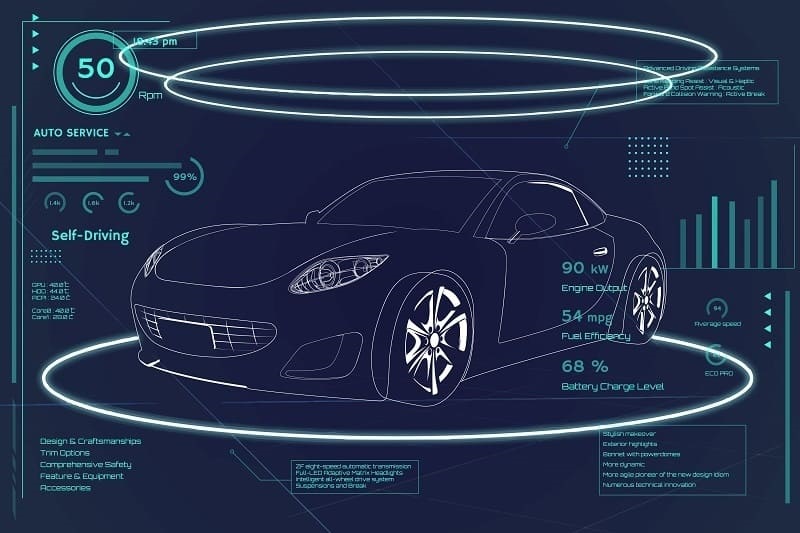As technology advances, the automobile industry continues to evolve to cater to the needs of modern-day drivers. One of the significant changes is the development of automatic cars. An automatic car is a type of vehicle that uses an automatic transmission instead of a manual transmission to shift gears automatically. In this article, we will explore the development, types, pros, and cons of automatic cars.
What Is an Automatic Car?

An automatic car is a vehicle that uses an automatic transmission to shift gears automatically. The transmission is designed to change gears based on the speed of the car, allowing the driver to focus on steering and other aspects of driving. The automatic transmission has evolved over the years, with the first one invented in 1921 by Alfred Horner Munro.
The development of automatic cars has been gradual over the years, with more sophisticated technology incorporated to enhance their performance. The transmission system has undergone several improvements to make the driving experience more convenient and enjoyable for drivers. Due to these improvements, automatic cars have become increasingly popular, with more drivers opting for this type of car.
Manual Transmission vs Automatic Transmission Cars
As a vehicle expert, it’s important to understand the differences between a manual transmission and automatic cars. Both have their advantages and disadvantages, and choosing the right type of car transmission is crucial to ensure a comfortable and enjoyable driving experience. In this article, we will discuss the pros and cons of manual and automatic transmission cars, compare the driving experience of both, and highlight the unique features and benefits of each type of automatic transmission.
Manual Transmission Cars: Pros and Cons
Manual transmission cars, also known as stick-shift cars, require the driver to manually shift gears using a clutch pedal and a gear shift. These cars offer better control over the vehicle and are typically more fuel-efficient than automatic transmission cars. Manual transmission cars also tend to be less expensive and easier to maintain, as they have fewer components than their automatic counterparts. However, manual cars can be more challenging to drive, especially in heavy traffic or on steep inclines. They also require more physical effort to operate, which can be a concern for drivers with mobility issues.
Automatic Transmission Cars: Pros and Cons
Automatic transmission cars, on the other hand, have a gearbox that automatically changes gears as the car accelerates or decelerates. These cars are easier to drive and require less effort from the driver, making them a popular choice for daily commuters. They also tend to offer smoother acceleration and provide a more comfortable driving experience. However, automatic transmission cars are typically more expensive than manual cars, both in terms of the purchase price and maintenance costs. They may also be less fuel-efficient and may not offer the same level of control as manual cars.
Driving Experience: Manual Transmission vs Automatic Transmission Cars
The driving experience of manual and gearless cars differs significantly.
Manual cars require the driver to shift gears manually, which can provide a more engaging and exciting driving experience. The driver has more control over the car’s speed and acceleration, which can be particularly useful for performance driving or off-road use. However, the need to manually shift gears can be a distraction for some drivers, and it may be challenging to maintain the same level of control in heavy traffic or on uneven terrain.
Gearless cars, on the other hand, provide a smoother and more effortless driving experience. The driver can focus on the road ahead and simply press the accelerator or brake pedals to control the car’s speed. This can be particularly useful in stop-and-go traffic or when driving long distances. However, gearless cars may not offer the same level of control as manual cars, and they can feel less engaging to drive.
Types of Automatic Transmission in Automobiles
Automatic transmission is a type of vehicle transmission that shifts gears automatically as the driver accelerates or decelerates the vehicle. There are several types of automatic transmission available in modern automobiles, each with its unique features and benefits. In this article, we will discuss the different types of automatic transmission and offer guidance on choosing the right type for your needs.
1. Traditional Automatic Transmission
The traditional automatic transmission, also known as the torque converter automatic transmission, is the most common type of automatic transmission. This type of transmission uses a torque converter to transfer power from the engine to the transmission. The torque converter works by using hydraulic fluid to transfer power from the engine to the transmission, allowing for seamless gear shifts.
The benefits of a traditional automatic transmission include ease of use, smooth gear shifts, and consistent performance. However, this type of transmission is less fuel-efficient compared to other types of automatic transmission.
2. Continuously Variable Transmission (CVT)
Continuously variable transmission (CVT) is a type of automatic transmission that uses a belt and pulley system to provide an infinite number of gear ratios. This means that the CVT can adjust the gear ratio continuously, providing a smooth and efficient driving experience.
The benefits of a CVT include better fuel economy, smoother acceleration, and reduced engine wear. However, some drivers may find the lack of traditional gear shifts disconcerting.
3. Dual-Clutch Transmission (DCT)
The dual-clutch transmission (DCT) is a type of automatic transmission that uses two clutches to shift gears. The transmission system utilizes two separate clutches, with one clutch responsible for engaging the odd-numbered gears and the other clutch responsible for engaging the even-numbered gears. This type of transmission provides quick and seamless gear shifts, resulting in a sporty and responsive driving experience.
The benefits of a DCT include improved fuel economy, faster acceleration, and reduced engine wear. However, this type of transmission can be expensive to repair and may require a steep learning curve for some drivers.
4. Automated Manual Transmission (AMT)
The automated manual transmission (AMT) is a type of transmission that uses a manual gearbox with an automated clutch system. This type of transmission provides the convenience of an automatic transmission with the fuel efficiency of a manual transmission.
The benefits of an AMT include better fuel economy, reduced driver fatigue, and lower maintenance costs. However, the AMT may provide a jerky driving experience, and some drivers may prefer the control of a traditional manual transmission.
Manual Transmission vs Automatic Transmission Cars: How to Choose the Right Type of Automatic Transmission for Your Needs
When choosing the right type of automatic transmission for your needs, it is essential to consider your driving habits, budget, and preferences. If you prioritize fuel efficiency and a smooth driving experience, the CVT or DCT may be the best choice. However, if you prefer the convenience of an automatic transmission with the fuel efficiency of a manual transmission, the AMT may be the best choice.
Advantages and Disadvantages of Driving an Automatic Car
One of the main advantages of driving a gearless car is the convenience and ease of use it provides. Unlike a manual transmission, drivers do not have to shift gears manually, making it easier to navigate through traffic and concentrate on driving. Automatic cars are also a great option for drivers who have limited mobility or physical disabilities.
However, one of the main disadvantages of an automatic car is that they are often more expensive than manual cars. Automatic cars also tend to be less fuel-efficient, which can lead to higher fuel costs in the long run. Additionally, some drivers may feel that driving an automatic car takes away from the experience of driving, as they are not actively involved in shifting gears.
How Automatic Transmission Affects Fuel Economy, Maintenance, and Performance
- When it comes to fuel economy, automatic cars tend to have lower gas mileage than manual cars. This is because the automatic transmission system uses more energy to shift gears, which can increase fuel consumption. However, modern automatic transmissions are designed to be more fuel-efficient than their predecessors, so this gap is narrowing.
- In terms of maintenance, automatic transmissions require regular maintenance and fluid changes, which can be more expensive than manual transmissions. If an automatic transmission is not properly maintained, it can lead to problems such as slipping gears, overheating, and ultimately, transmission failure. On the other hand, if properly maintained, an automatic transmission can last for hundreds of thousands of miles.
- When it comes to performance, automatic transmissions provide smoother and faster acceleration than manual transmissions. They also make it easier to drive in traffic or on hilly terrain, as the transmission automatically shifts to the appropriate gear. However, some drivers may find that the shifting of gears in an automatic transmission is not as precise as in a manual transmission, which can impact the overall driving experience.
Benefits of Owning an Automatic Car
Despite the disadvantages mentioned above, owning a gearless car has many benefits.
One of the main advantages is the convenience it provides. With an automatic transmission, drivers can focus on the road ahead and not worry about shifting gears, which can be especially beneficial in heavy traffic.
Automatic cars are also a great option for those who have to drive in hilly or mountainous areas, as they can easily shift to the appropriate gear without any input from the driver.
Conclusion
There are various pros and cons to owning Manual Transmission vs Automatic Transmission Cars. And after exploring the pros and cons of automatic cars, it’s clear that these vehicles have come a long way since they were first introduced. They offer a variety of benefits such as smooth gear changes, better fuel efficiency, and reduced driver fatigue. However, it’s important for drivers to weigh these advantages against the higher cost, potential maintenance issues, and lack of control over gear shifting. Ultimately, the decision to choose an automatic car over a manual car should come down to individual needs and preferences. As a vehicle expert, I would encourage readers to consider their driving habits, commute, and budget before making a decision. Whether it’s a classic stick shift or a modern automatic transmission, what matters most is finding the right fit for your lifestyle.
Image Credit: freepik.com
